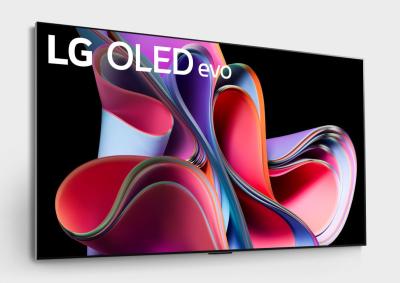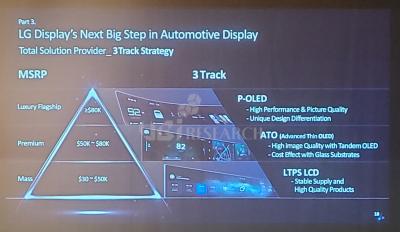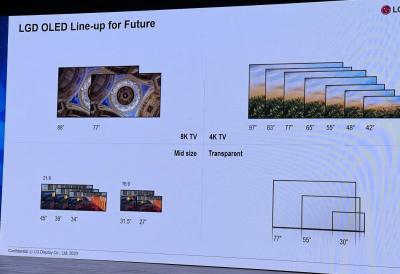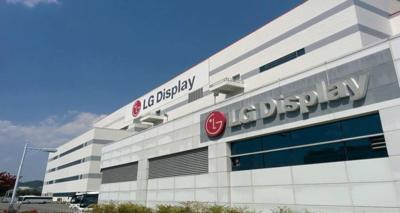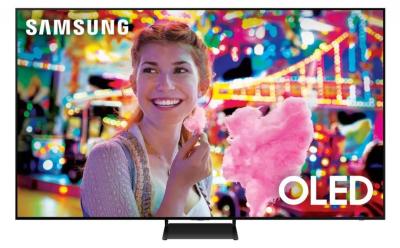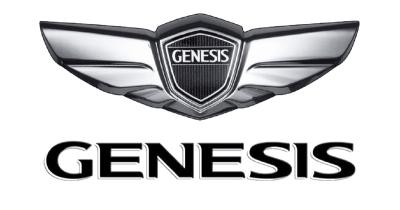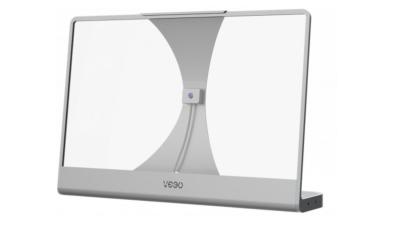OLED is an emerging display technology that uses thin films of organic materials to make efficient, thin and high quality displays. OLED panels can made flexible, rollable and transparent. Korea's LG is at the forefront of OLED development and production - as the world's leading OLED TV producer and a leading developer of flexible OLED for smartphones, wearables, automotive and more. LG's subsidiary LG Display is responsible for OLED R&D and panel production, while LG Electronics produces and markets OLED TVs.
LG OLED TVs
LG Display is the world's leading OLED TV panel producer, and LG Electronics is its largest customer - although LGD also supplies OLED panels to other companies including including Panasonic, Sony, Philips, Loewe, JVC, Hisense, Konka and others. OLED TVs are considered the world's best TVs, offering the best image quality. LG makes a wide range of OLED TV panels, ranging from 42-inch to 97-inch, including bendable solutions and even a rollable 65" TV.
While the basic OLED TV design uses RGB OLED sub-pixels to create each 'pixel' (what is referred to as direct emission OLED, the design used in mobile OLED displays used in Samsung's and Apple's smartphones, for example), LG Display opted for a different OLED TV design. The so-called WRGB (or WOLED-CF) architecture uses four white OLED subpixels with color filters on top (hence W+RBG). The WRGB technology (developed by Kodak and now owned by LG Display) is much easier to produce and scale-up, even though it has some technical disadvantages - and it is the technology that enabled LG to be the first company to actually produce commercial OLED TV panels.
LG Flexible OLEDs
LG currently produces flexible OLEDs (branded as pOLEDs), for both wearable devices and smartphones. LG is the leading supplier of AMOLED displays for Apple's Watch smartwatch and it also supplies OLED displays for smartphones. Click here for more information on LG's pOLED displays and its production capabilities.
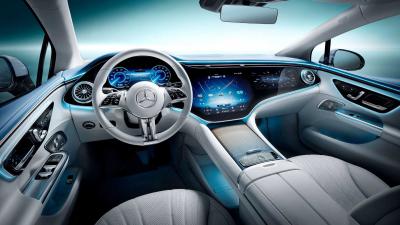
LG is also the world's leading automotive OLED producer, and is already supplying flexible OLEDs to Cadillac, Mercedes, and others.
LG Transparent OLEDs
LG has been working on transparent OLEDs for many years. In 2014 LGD unveiled a 18" transparent OLED prototype, and later in 2016 LGD demonstrated transparent 55" FHD AMOLED display prototypes. In 2019, the company started commercial production of 55" FHD transparent OLEDs, finding small markets in signage, commercial, mobility and more.
Further reading
The latest LG OLED news:
LG Display reveals its automotive display strategy and its latest OLED customers
LG Display detailed its latest automotive display strategy. The company is now offering three product family. For luxury flagship cars (over $80,000 in cost), the company is offering its P-OLED flexible panels, that offer high performance coupled with design freedom.
For premium cars ($50,000 - $80,000) the company offers rigid OLEDs, that offer high image quality and a tandem OLED architecture for increased efficiency and lifetime. These displays are lower in cost compared to LG's P-OLEDs, and LG brands these as ATO (Advanced Thin OLEDs) as they adopt TFE encapsulation over a glass substrate. For mass market cars ($30,000 - $50,000) LGD offers LTPS LCDs.
LG Display strenghten its premium automotive display partnership with Mercedes-Benz
LG Display announced that it is strengthening its partnership and collaboration with Mercedes-Benz. The two companies started working together in 2004, and since then the German carmaker has been applying cutting-edge automotive displays from LGD to its luxury vehicles.
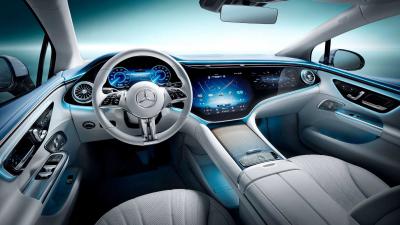
Mercedes has been applying LGD's OLEDs for several years, and so it is not clear what will now change, but it is likely that we'll see more Mercedes models adopting high-end displays from LGD, mostly OLEDs. The Mercedes EQE 2022, for example, uses either a 12.8-inch AMOLED or (optionally) Mercedes' MBUX Hyperscreen, a 56-inch display, actually made from three different OLED units, embedded in a single glass display. There's a central 17.7-inch panel plus two 12.3-inch panels. The 56-inch glass also includes holes for the air-vents which are integrated into the display.
LG to soon start producing 32", 34" and 39" WOLED panels
LG Display showed its WOLED roadmap during the K-Display conference in Seoul, saying that it will soon start producing 32-inch (16:9), 34-inch (21:9) and 39-inch (21:9) models. These panels are aimed for computer monitor applications, rather than TVs, although the 32-inch could also be used as a TV panel.
LGD did not detail when it expects to start producing these panels. Dough already unveiled a few weeks ago that it is working on a 32" monitor, and this will be base on an LGD WOLED panel
LG Display demonstrated its 30" and 77" transparent OLED displays for the first time
LG Display is demonstrating its new 30" and 77" transparent OLED displays for the first time, at the company's booth at K-Display 2023, in Seoul, Korea.
Credit: LG Display
The new 30" transparent OLED offers HD resolution, while the 77" panel offers 4K resolution. All of LG's latest transparent OLED displays offer 45% transparency. LG showed its entire range of T-OLED displays in a coffee shop setting, in partnership with Starbucks.
LGD reports its financial results for Q2 2023, is on track in its 6-Gen line, but delays plans for an 8-Gen laptop OLED line
LG Display reported its financial results for Q2 2023, with revenues of 4.74 trillion Won ($3.7 billion USD) - up 7% from last quarter, and an operating loss of 881 billion Won ($690 million USD). LGD says that demand for display panels increased during the quarter.
LGD is on track to begin mass production of medium-sized panels in the first half of 2024, building a new 6-Gen production line, that is reportedly aimed to supply for Apple's iPad Pro, the first Apple tablet to sport an AMOLED display.
Samsung and LG are developing bezel-less smartphone OLED displays for Apple
According to a report from Korea, Apple approached both LG Display and Samsung Display, asking its suppliers to develop a completely bezel-less AMOLED display for future iPhones.
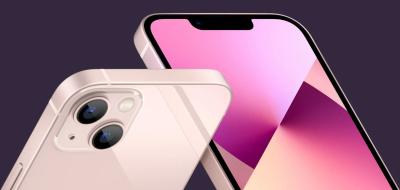
Designing an OLED without a bezel is a challenge, mostly because of the encapsulation layer that has to protect the OLEDs. Using an under-the-display camera is also said to be a problem for the OLED makers in such a design.
Omdia: the automotive OLED market is set to grow to $2.17 billion in revenues by 2027
According to market research firm Omdia, the OLED automotive displays market is set to grow to $2.17 billion in 2027, up from $481.75 in 2023 (that's a 4.5X growth in sales). In terms of shipments, the market will reach 9 million units in 2027, up from 1.48 million in 2023 (a 7X growth).
Omdia is actually more optimistic about the automotive market than it was last year, as the industry is growing faster than expected. There is a rapid uptake of AMOLED displays in premium cars, as the displays offer a better image quality, lower power consumption and lower weight compared to LCDs, which is all very important for electric cars.
Samsung officially launches its first OLED TV based on LG's 83" 4K WOLED panels
Samsung officially launched the 83S90C, the company's first TV to use LG's WOLED panels. It uses a 4K 120K 83" OLED display, and is powered by Samsung's AI-powered Neural Quantum Processor. The S83S90C will start shipping in a few days in the US, with a suggested price of $5,400.
Interestingly, Samsung decided to have its first WOLED TV sit in the same range as its QD-OLED TVs, the S90C, which includes 55-, 65- and 77-inch QD-OLED TV panels. It's likely the company will try to blur the differences between the QD-OLED and the WOLED panels, and not discuss too much its reliance on LG Display's supply.
Business Korea: the upcoming Genesis GV80 will use a 27-inch AMOLED display produced by LG Display
According to a new report from Business Korea, the upcoming new version of the GV80 Hyundai Motor's Genesis car will adopt a large OLED display, the first car by Hyundai to use an OLED as the main display. The GV80 will use a 27" P-OLED display produced by LG Display, that will be used to connect the instrument cluster and the navigation and audio-system center console The GV80 will be introduced before the end of 2023.
LG Display was one of the first companies to identify the automotive industry as a potential market for its AMOLED displays. LGD is already supplying OLED panels to several companies including Mercedes and Cadillac. In 2021 it was estimated that LGD holds a market share of over 90% in automotive AMOLEDs, and the company is now considering building a dedicated AMOLED production line for automotive displays.
Veeo launches transparent 30" and 55" OLED monitors with a behind-the-screen camera
US-based Veeo announce a new display called the T30, that is based on a transparent OLED panel with a behind-the-display camera. The T30 is a monitor that enables video communication with an aligned user line of sight.
The T30 is offered in two models, 30" and 50", both based on LG's transparent WOLED panels. Veeo will announce the price of its transparent OLED monitor towards the end of 2023.
Pagination
- Previous page
- Page 6
- Next page
